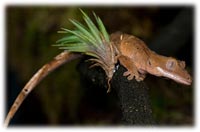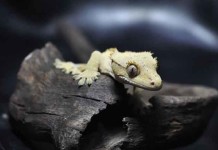The crested gecko, Rhacodactylus ciliatus, was thought extinct until it was rediscovered after a storm in 1994. Since its rediscovery in New Caledonia, crested gecko information has flooded the reptile world and the species has become one of the most popular among breeders and keepers.
The crested gecko gets its name from the fringe that runs from over its eyes down its entire back. They are also called “eyelash gecko” for this reason. They are affectionately referred to as “cresties.”
Crested geckos are polymorphic, meaning that they have multiple color and pattern variations. They also change color, depending on the time of day and their mood. Their color is somewhat drab during the day but at night their color becomes vibrant. This is referred to as being “fired up.”
The life expectancy of the crested gecko has been estimated between 10 and 15 years. Their average length from snout to tail is 8” and they generally weigh between 32 and 45 grams.
The crested gecko is nocturnal, sleeping during the day and becoming active at night. They enjoy the company of other crested geckos, often curling up under plant leaves with another. Often they will sleep on the surface glass of their enclosure hanging upside down.
This unique reptile does not have eyelids. Instead, the crested gecko’s eyes are covered by a protective membrane. They use their tongue to clean away debris and moisten their eyes.
 The crested gecko is quite docile and each one has an individual personality. They can acclimate to being handled. The one thing to look out for when handling the crested gecko is that they are jumpers. They will take a flying leap off your hand if you are not careful.
The crested gecko is quite docile and each one has an individual personality. They can acclimate to being handled. The one thing to look out for when handling the crested gecko is that they are jumpers. They will take a flying leap off your hand if you are not careful.
Their tails often fall off due to stress, predators in the wild or lack of blood flow due to improper sheds. Their tails do not grow back. The crested gecko sheds regularly and requires the proper hydration and humidity to do so without complications.
Males should not be housed together unless they are hatchlings under four months old. It is preferable to house up to two females with one male in a 29-gallon tank. The crested gecko is a natural climber and requires tall enclosures with variable climbing surfaces.
Overall, there is much crested gecko information still to be learned. However, we know that they are certainly unique and have taken the reptile pet market by storm. Every day, breeders are discovering new morphs and combinations that make this already distinctive reptile even more so.
More About the Crested Geckos
More interesting facts and information about this reptile.
The Origin of Crested Gecko
The origin of crested gecko is a place that is warm, humid and diverse with plants.
Wild Crested Gecko
The wild crested gecko is found in New Caledonia. Find out more about them here!
Facts about Crestie
Find out the most import facts about this reptile.
The Unique Crested Gecko Foot
How does the unique foot of crestie helping them climbing different types of surfaces.
Crested Gecko Sleeping Habits
The interesting sleeping habits of crestie that you may want to know!
The Appeal of Crested Gecko
It’s unique looking; its wonderful temperament and its ease of care as a pet.














